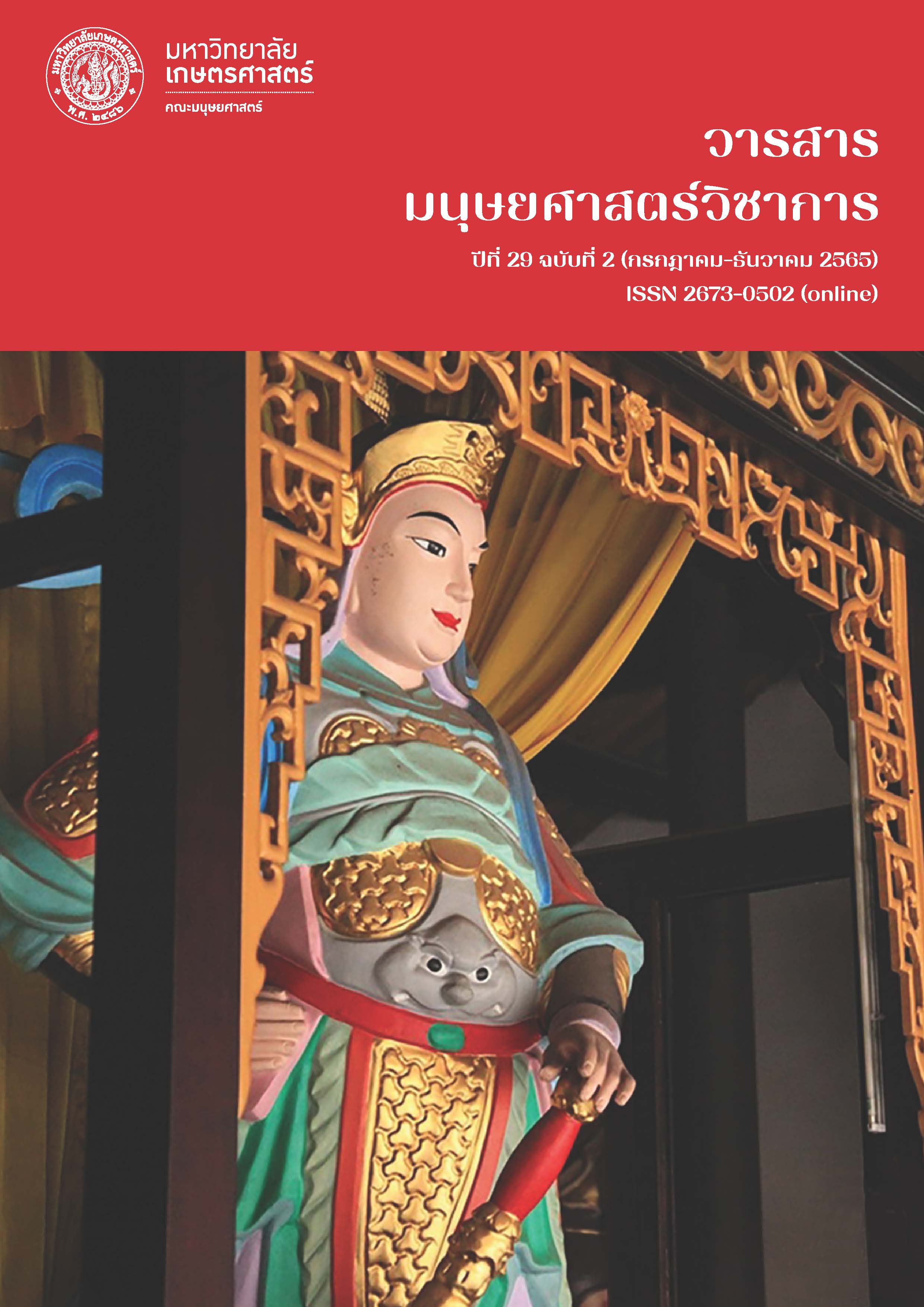Assessing the Potential of Tourism Products by the Tai Lue Community in Nan Province: Perspectives of Local Leaders
Main Article Content
Abstract
This research aims to 1) conduct a survey on Tai Lue community tourism; and 2) assess tourism product potential in Pua and Tha Wang Pha Districts, with the highest population density of Tai Lue people in Nan Province. Qualitative research was done. Samples were village headmen in Pua and Tha Wang Pha Districts obtained by random selection. Research tools included semi-structured interviews. Data were analyzed and synthesized by qualitative research principles and using content analysis. The goal was to formulate guidelines to develop tourism activities.
Results were that developing community tourism products was important, with community attractions valued by community lifestyles. Unique tourism areas offering community attractions possess historical, traditional, and cultural values, with higher safety from natural disasters and lower crime statistics than externally-based tourism businesses involved in meeting the needs of tourists, including accommodations (hotels, home stays) and souvenir shops. Communications resources should be developed to inform potential tourists about news and activities. Community tourism attractions should focus on search options for tourist information from maps/online travel routes (Google Maps) and Google (google.com). Among suitable community features to be future focuses for tourism attractions are festivals, livelihoods, arts and cultural centers, local memory preservation efforts, and indigenous woven products of the Tai Lue community. In evaluating tourism attractiveness potential/attraction value, emphasis was placed on tourist attractions that enhance local community income, especially unique and distinctive areas. Potential for tourism development, focusing on tourist attractions, and community tourist sites of communications systems (telephone/internet) in all areas should be studied, including different types of requirements to meet needs and standards. The potential for tourism development, emphasizing community participation in tourism management, will thereby support tourism activity development with the governmental and private sectors at provincial levels.
Article Details

This work is licensed under a Creative Commons Attribution-NonCommercial-NoDerivatives 4.0 International License.
References
กระทรวงการท่องเที่ยวและกีฬา. (25 มกราคม 2562). สถิตินักท่องเที่ยวภายในประเทศ. สืบค้นเมื่อ 25 มกราคม 2562 จาก https://www.mots.go.th/more_news_new.php?cid=531.
กัญญารินทร์ ไชยจันทร์. (2558). ความต้องการด้านการท่องเที่ยววิถีไทย: กรณีศึกษาวัยรุ่นที่ศึกษาในมหาวิทยาลัยธรรมศาสตร์. กรุงเทพฯ: สถาบันไทยคดีศึกษา มหาวิทยาลัยธรรมศาสตร์.
การท่องเที่ยวแห่งประเทศไทย. (25 พฤศจิกายน 2561). 2015 Discover THAINESS / ท่องเที่ยววิถีไทย 2558. สืบค้นเมื่อ 25 พฤศจิกายน 2561 จาก TAT Review Magazine: http://www.etatjournal.com/mobile/ index.php/menu-read-tat/menu-2015/menu-12015/219-12015-discover-thainess.
จังหวัดน่าน. (23 มกราคม 2562). ประวัติศาสตร์น่าน. สืบค้นเมื่อ 23 มกราคม 2562 จาก http://www.nan.go.th/webjo/index.php?option=com_content&view=article&id=6&Itemid=27.
บุญเลิศ จิตตั้งวัฒนา. (2548). การพัฒนาการท่องเที่ยวแบบยั่งยืน. กรุงเทพฯ: ศูนย์วิชาการท่องเที่ยวแห่งประเทศไทย.
มิ่งกมล หงษาวงศ์. (2557). ไทลื้อ: วิถีชีวิตและอัตลักษณ์ทางวัฒนธรรม. วารสารศิลปกรรมศาสตร์วิชาการ วิจัยและงานสร้างสรรค์ ราชมงคลธัญบุรี, 1(2), 1-20.
รัดเกล้า เปรมประสิทธิ์. (2557). การพัฒนาศักยภาพแหล่งท่องเที่ยวอำเภอปัว จังหวัดน่าน. วารสารอารยธรรมศึกษาโขง-สาละวิน, 5(1), 28-41.
เลหล้า ตรีเอกานุกูล. (2557). ทุนทางสังคมและวัฒนธรรมของจังหวัดน่านต่อการส่งเสริมการเป็นเมืองเก่าที่มีชีวิต. วารสารวิจัยเพื่อการพัฒนาเชิงพื้นที่, 6(3), 93-106.
วิลาสินี จินตลิขิตดี และเอนก เหล่าธรรมทัศน์. (2561). รัฐประศาสนศาสตร์เพื่อการท่องเที่ยว: บทบาทขององค์กรปกครองส่วนท้องถิ่นในการจัดการการท่องเที่ยว เพื่อการอนุรักษ์ ฟื้นฟู และพัฒนาวัฒนธรรม: กรณีศึกษา เทศบาลตำบลเชียงคาน เทศบาลเมืองน่าน และเทศบาลนครเชียงใหม่. วารสารเกษมบัณฑิต, 19(ฉบับพิเศษ), 312-323.
วิไลลักษณ์ กิติบุตร. (2551). การพัฒนาสินค้าชุมชนไทลื้อ อำเภอดอยสะเก็ด จังหวัดเชียงใหม่ สู่มาตรฐานผลิตภัณฑ์ชุมชนและท้องถิ่น (OTOP). วารสารวิจัยราชภัฏเชียงใหม่, 10(1), 55-67.
สถาบันวิจัยสังคม มหาวิทยาลัยเชียงใหม่. (16 สิงหาคม 2561). ศูนย์เรียนรู้ชาติพันธุ์ไทในล้านนา. สืบค้นเมื่อ 16 สิงหาคม 2561 จาก http://www.sri.cmu.ac.th/~lelc/index.php/2015-11-18-16-02-20.
สำนักงานสภาพัฒนาการเศรษฐกิจและสังคมแห่งชาติ. (19 ธันวาคม 2561). สืบค้นเมื่อ 19 ธันวาคม 2561 จาก https://www.nesdc.go.th/ewt_dl_link.php?nid=6422.
โอริสา เชี่ยวเกษม. (2558). การท่องเที่ยวเชิงวัฒนธรรมในชุมชนไตลื้อ ตำบลบ้านถิ่น อำเภอเมืองแพร่ จังหวัดแพร่. กรุงเทพฯ: มหาวิทยาลัยราชภัฏธนบุรี.

